
Scottish sculptor, graphic artist, philanthropist and feigned madman. Also saw the future. (1924-2005) By Frank Thurston. 1988.
He slept where he worked, on a makeshift loft in the absolute chaos of his studio, to make sure his imagination would be sparked first thing in the morning. The man ate, drank, walked, and slept art 24/7. And art was anything he could stick together into some new unexpected form: magazine adverts and Disney stickers, recycled metal, garbage of many varieties, plaster and bits of wood…there is no end to the creativity. Like Hemingway, he always left an unfinished piece to return to the next day.
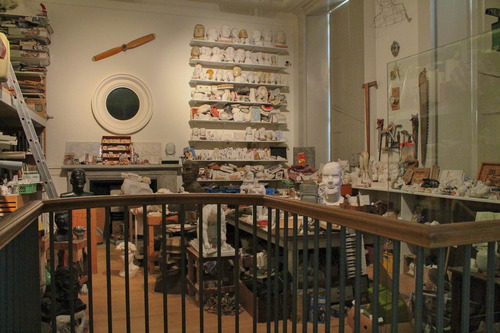
Inspiration and work. Edoardo Paolozzi’s Studio in the Scottish National Gallery of Modern Art. Photo by Ezinda Franklin-Houtzager.
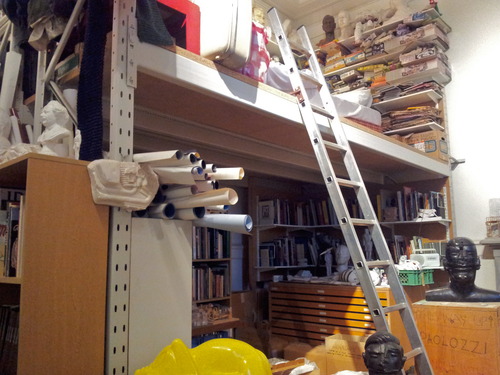
And for sleep, the loft. Photo by Pepe Houtzager.
It didn’t start off that well. Edoardo Paolozzi was born in the working class neighborhood Leith, Edinburgh, the son of Italian immigrants who ran an ice cream parlor. At age 16, as World War II started, his government decided to intern or deport everyone of ‘hostile origin’ to Canada or Australia. He was rounded up by the police along with thousands of other Italian and German immigrant men and interned. Without any sense of irony the British government then conscripted him three years later. Paolozzi feigned insanity and was quickly discharged. His father, grandfather and uncle had less luck. They were shipped off to Canada despite the German U-boats prowling the Atlantic waters. They never arrived. Their floating prison was torpedoed and they drowned alongside 443 other Italian men.
Paolozzi’s dislike for the British government notwithstanding, he didn’t mind being knighted in 1989 at age 81.
A sign that some people really can’t change, the Telegraph newspaper’s obit for Paolozzi in 2005 observed ‘Baboon-like in appearance, he could often be seen searching for junk near his home in Chelsea, or lugging cast items to and from a nearby foundry.’ Classy eh?
Surprisingly given his family U-boat history, he loved Germany, perhaps for its industrial engineering prowess. He taught there during the early 1960s and again a decade later. His students included Stuart Sutcliffe, one of the original Beatles. Paolozzi also did the cover of Paul McCartney’s Red Rose Speedway album.
Unable to resist, he collected bits of ship debris from the wrecking yards in the Hamburg dry docks. He slept on a camp bed in his cluttered studio at the Munich Academy.
It’s Paolozzi’s weird organic-machine sculptures at the Scottish National Gallery of Modern Art that first caught our attention. Cold geometric strips of metal flesh welded into vulnerable human form, Vulcan the awkward god of fire and blacksmith to the gods. On the lawn, a crouching iron Master of the Universe, Isaac Newton, who could be mistaken for one of the Borg (apologies for Star Trek reference). How Paolozzi transformed the utter chaos of his studio into pieces that give off such a sense of completeness, with everything in its proper (unexpected) place, is a mystery. One can only conclude that the human brain is a magical thing.
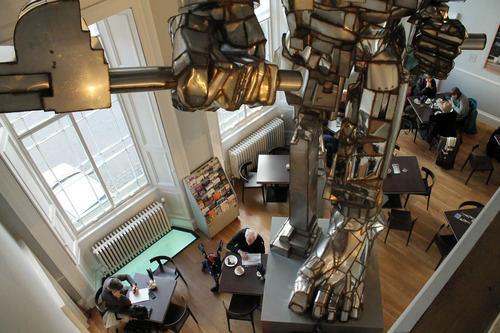
That’s damn big! Vulcan the venerable marching through the cafe! 1998-99. Photo by Ezinda Franklin-Houtzager.
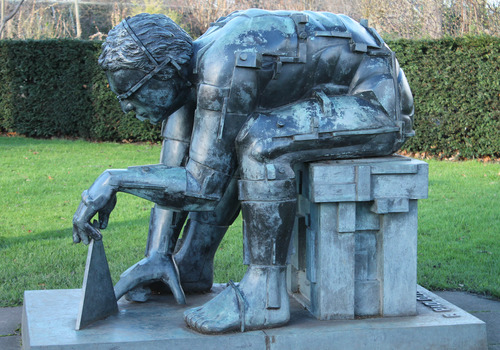
Master of the Universe, Isaac Newton, measuring the lawn of the Scottish National Gallery of Modern Art. Photo by Ezinda Franklin-Houtzager.
For those who like a good walk and were smart enough to get to Edinburgh, start at Saint Mary’s Roman Catholic Cathedral and Paolozzi’s three bronze sculptures of the Manuscript of Monte Cassino (1). The very large hand, big foot, and thick ankle are a tribute to the idea of pilgrimages. Proceed to the nearby Omni Center for the Ankle (2). Then walk through the richly green Queen Street Gardens that run alongside Edinburgh rock castle, through the medieval district of Leith, and up to the Scottish Gallery of Modern Art (3). There are statues all the way, though master Paolozzi’s work only reappears on the lawns of the Gallery of Modern Art.
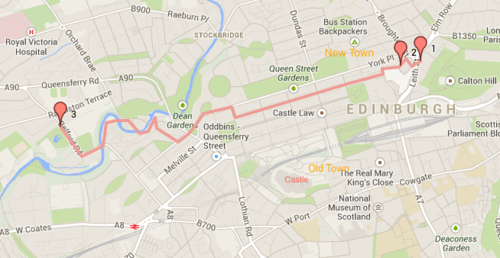
Paolozzi trail in Edinburgh, just north-west of Arthur’s Seat and Old Town. (1) St. Mary’s RC Cathedral, (2) Omni Centre, and (3) Scottish Gallery of Modern Art.
If you are caught in London, don’t despair. There is the mega-machine head on the south bank of the Thames by London’s Tower Bridge. It sits in front of what was said to be the largest tea warehouse in the world in the late 1800s. You can spot the building, but not the head, in Doctor Who serial Resurrection of the Daleks (1984).
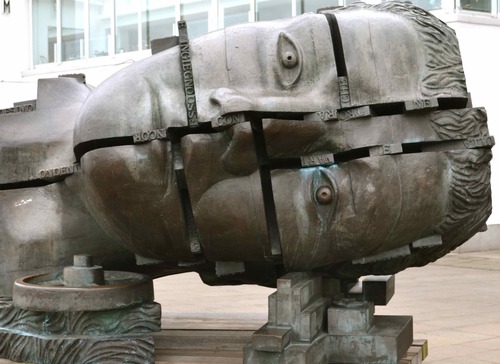
Assembly required. Head of Invention in front of the Design Museum at Butler’s Wharf, London 1989.
Below ground, Paolozzi shows that he is just as comfortable working in two dimensions as in three with his brightly colored glass mosaics on the walls of Tottenham Court Road Tube station in London.
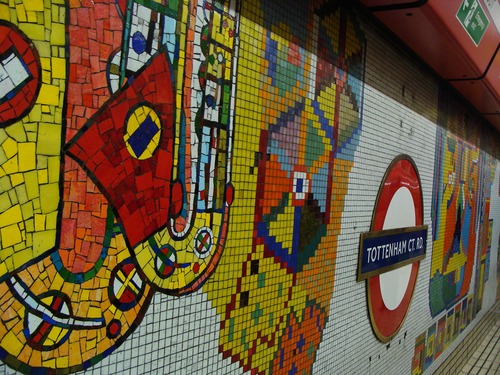
Mosaic at Tottenham Court Road Tube Station, London.
Tottenham Court Road station turns out to be the tip of the iceberg. Unbeknown to us, Paolozzi is all over London. There are sculptures at Euston Station, the British Library, and Kew Gardens. Tate Britain has 384 pieces, a mix of collages, sculptures, textiles, and ceramics. Next up for us, a Paolozzi London tour, once Spring arrives.
By Mr. & Mrs. Rivaat Zarlif
Sources
- http://www.telegraph.co.uk/news/obituaries/1488447/Sir-Eduardo-Paolozzi…
- Sir Eduardo Paolozzi
- http://www.theguardian.com/culture/2005/apr/22/obituaries
- Sir Eduardo Paolozzi









